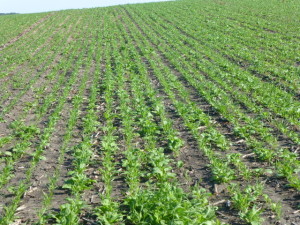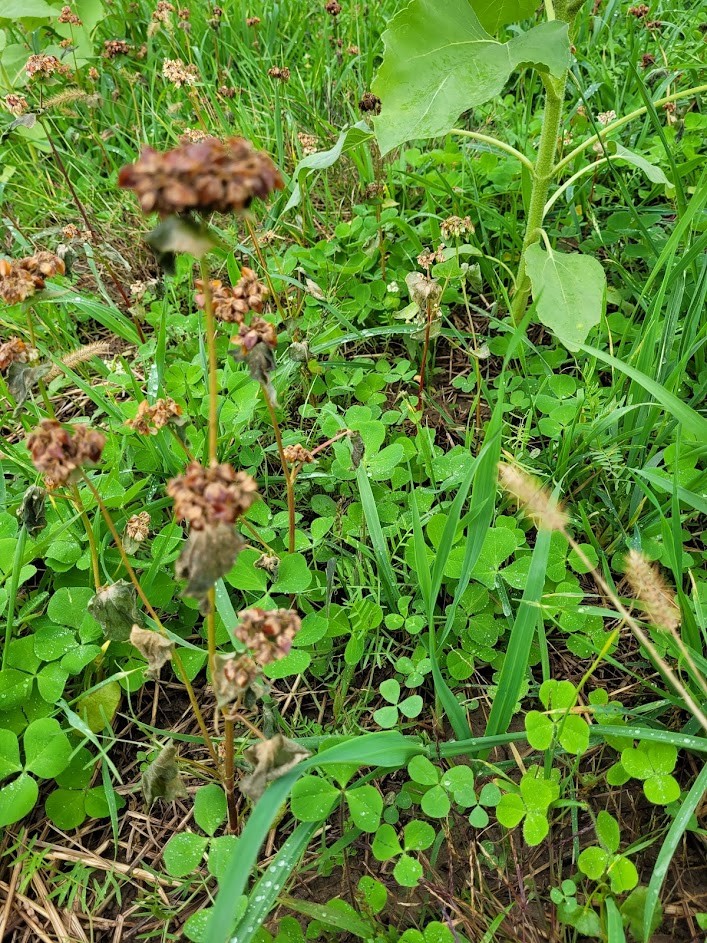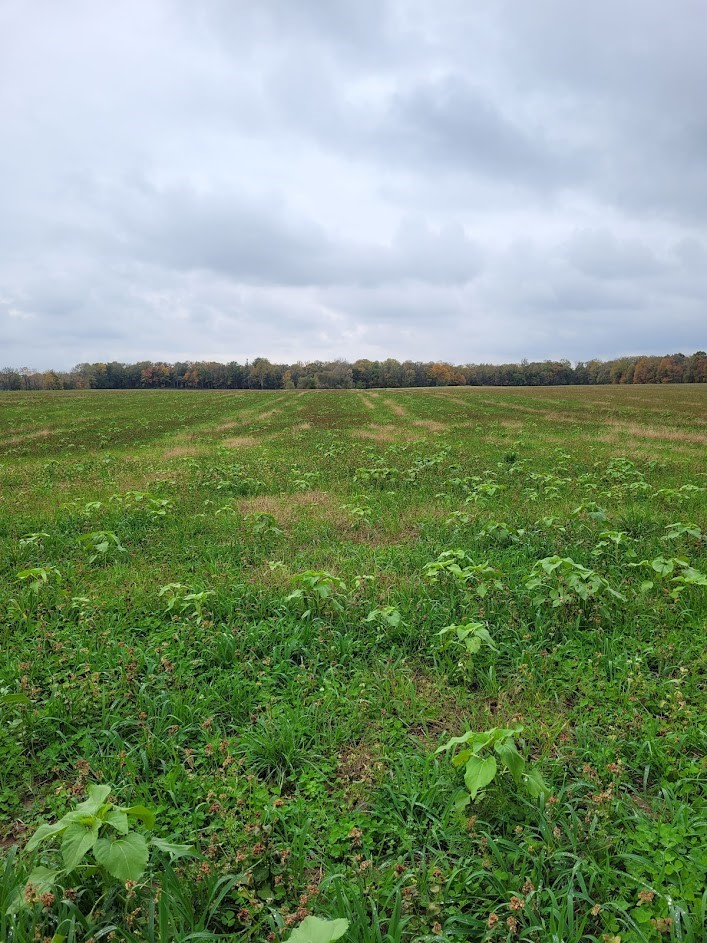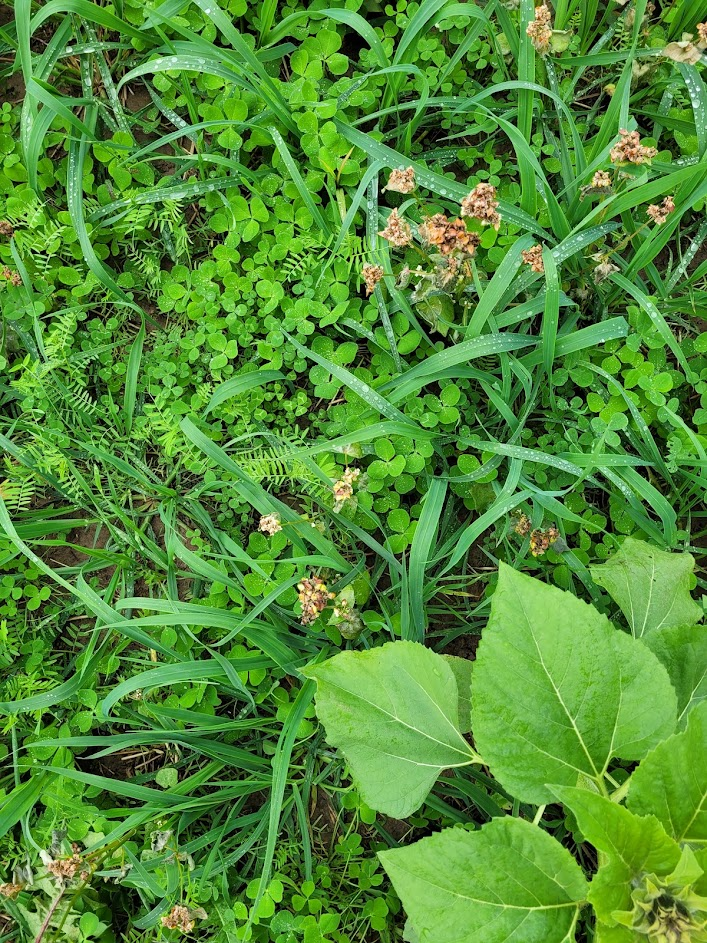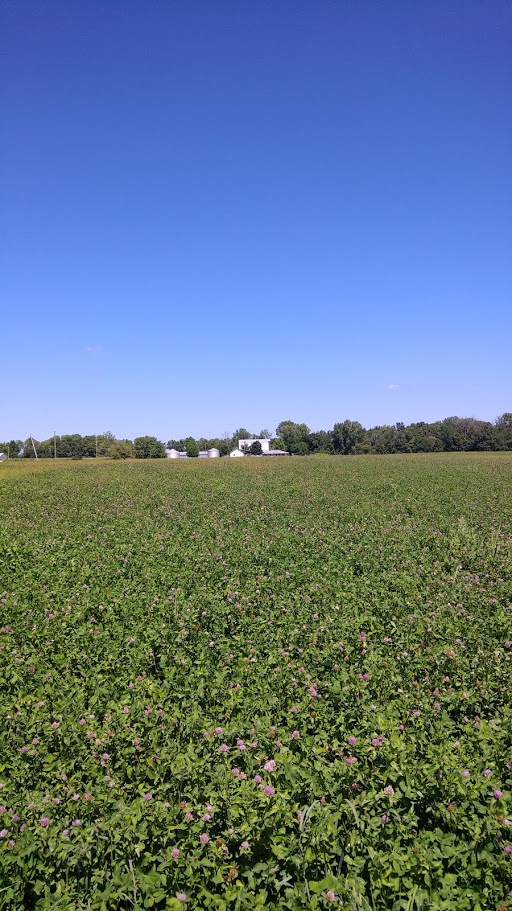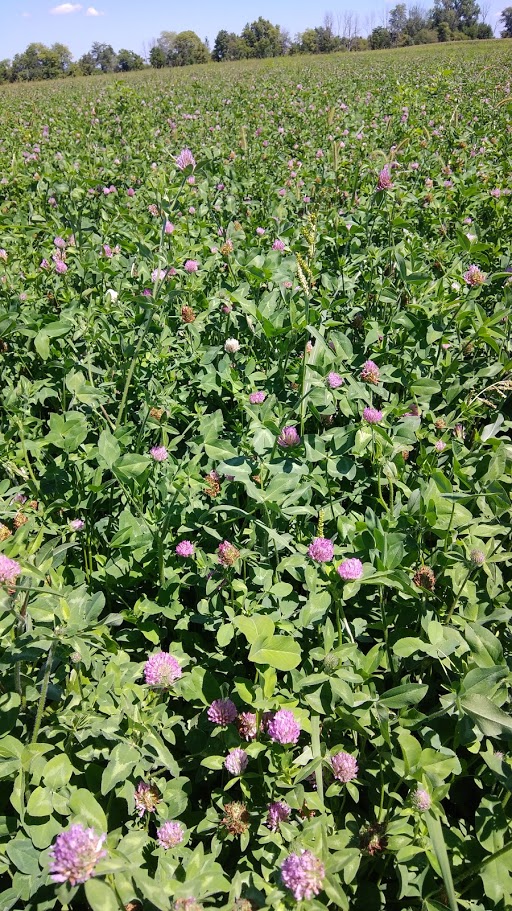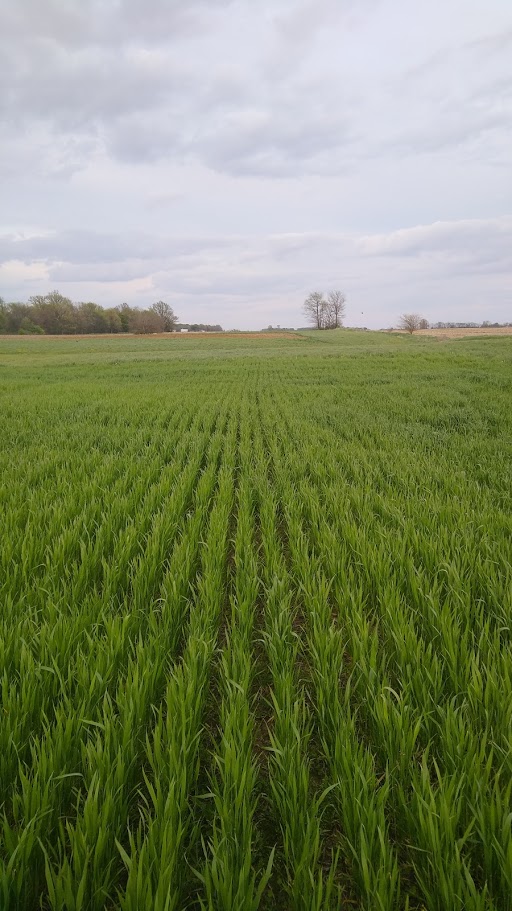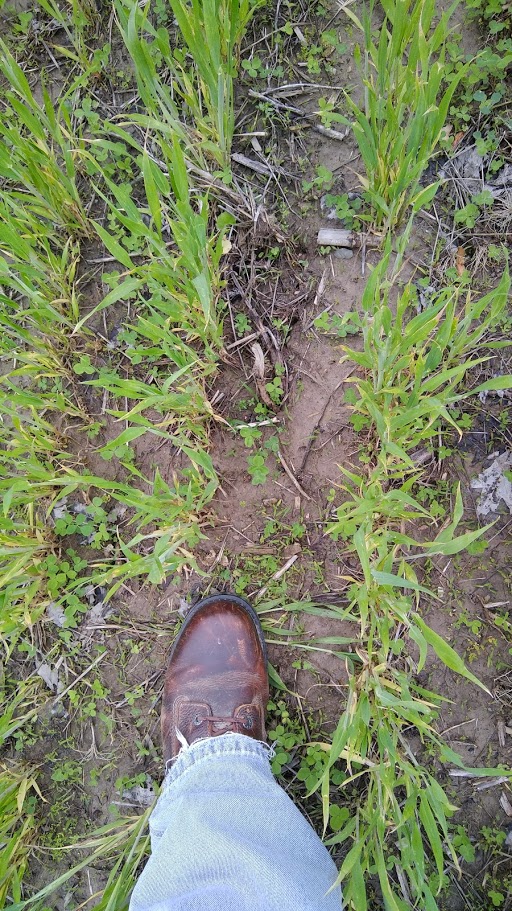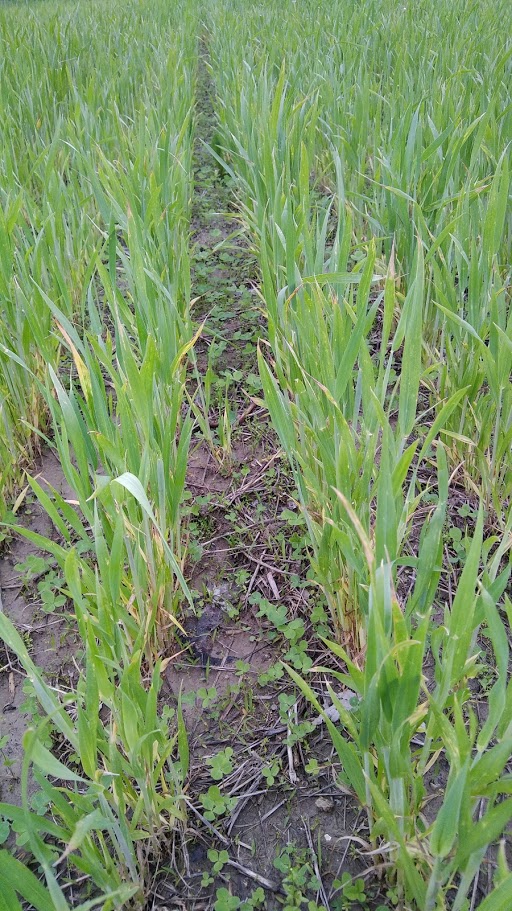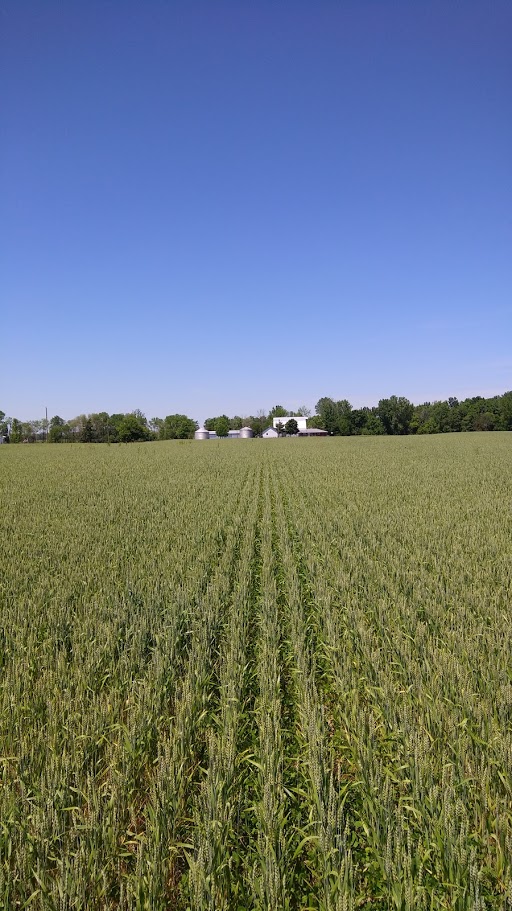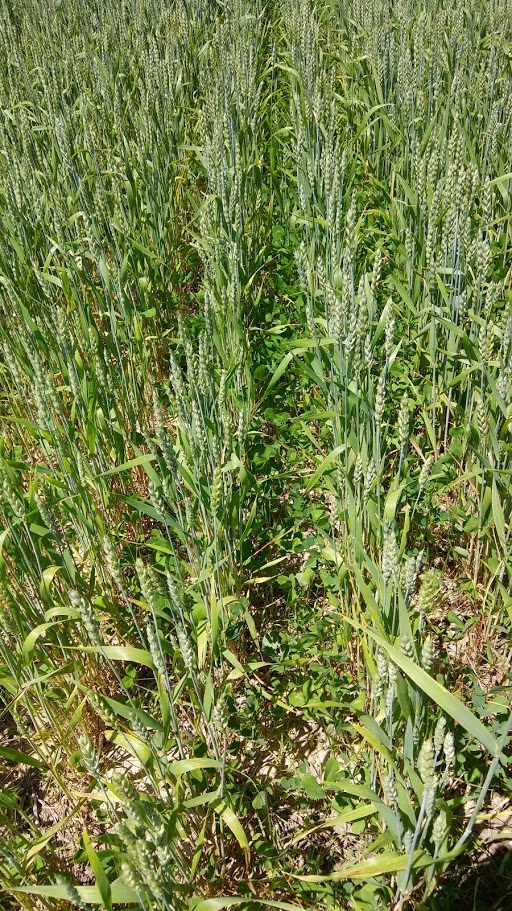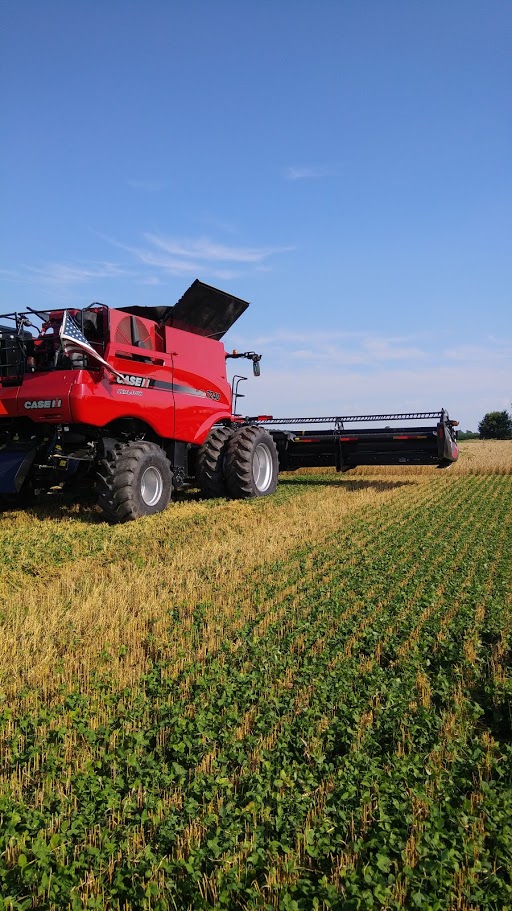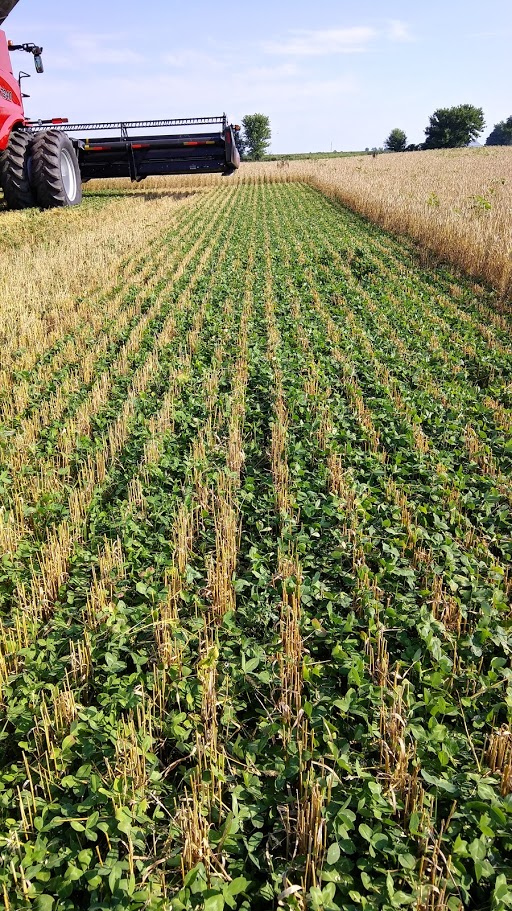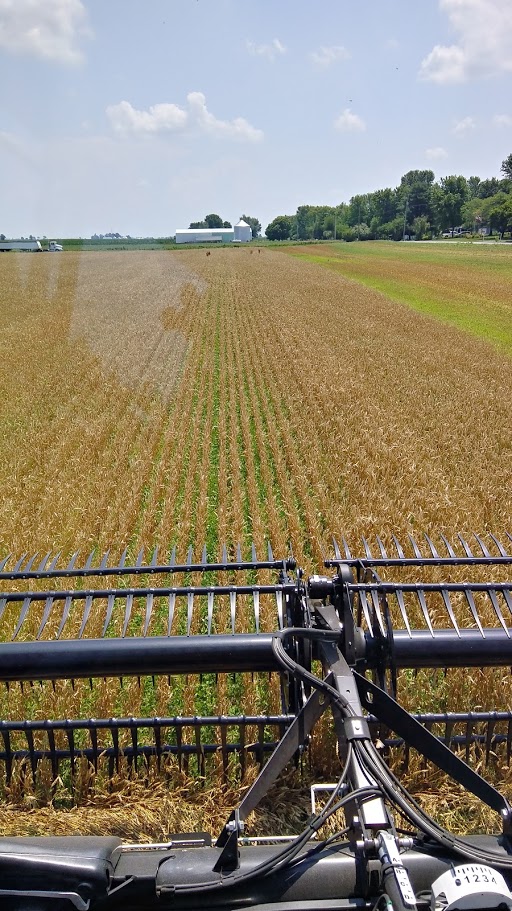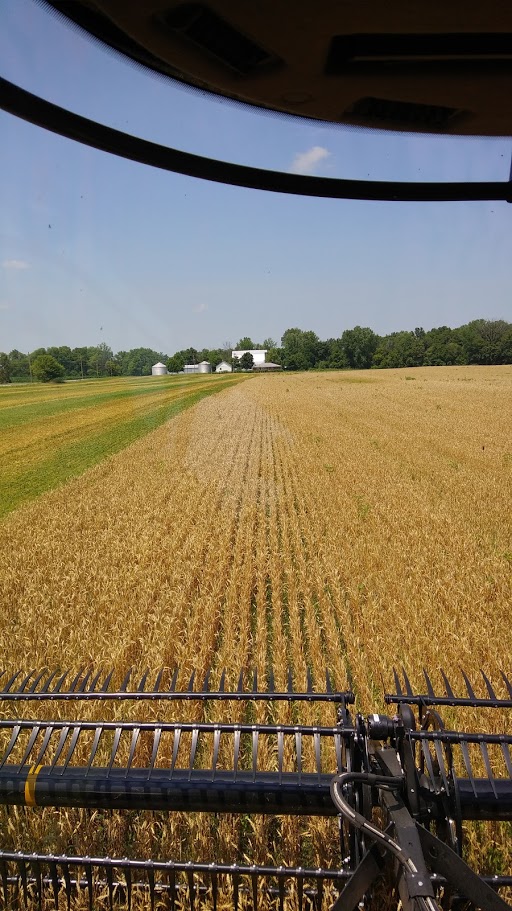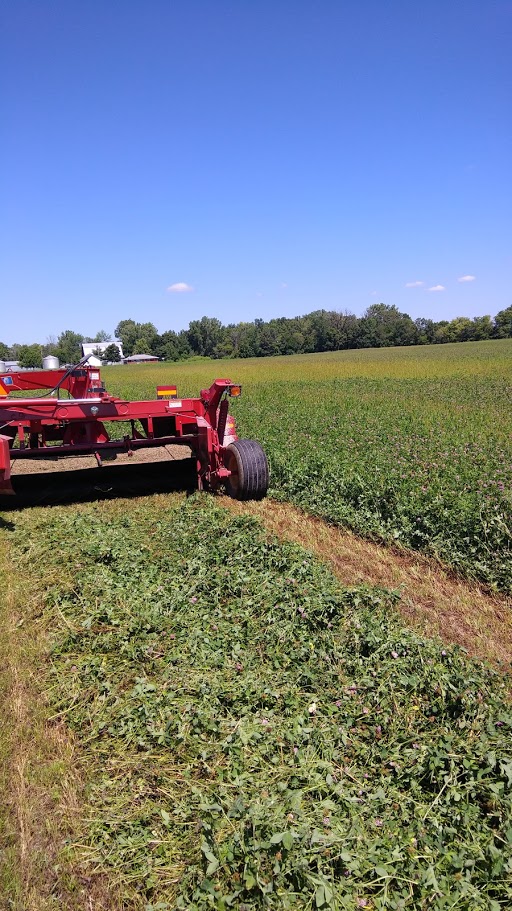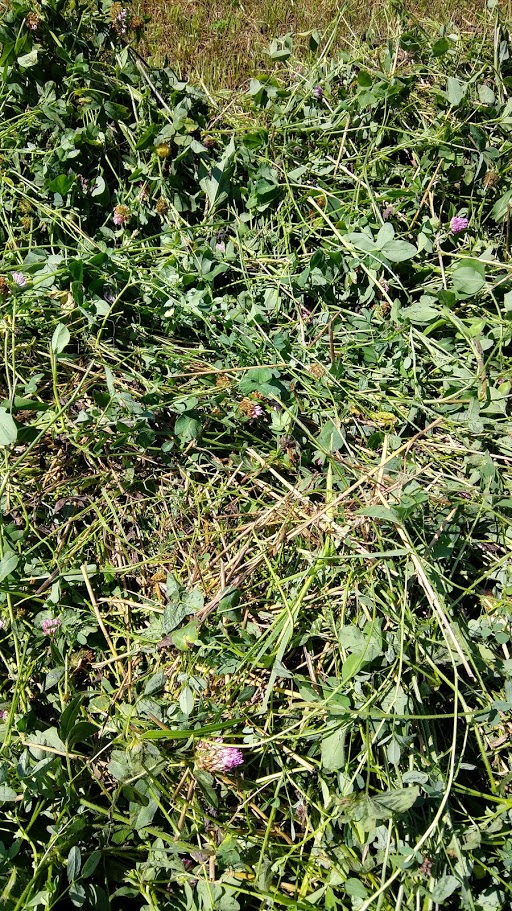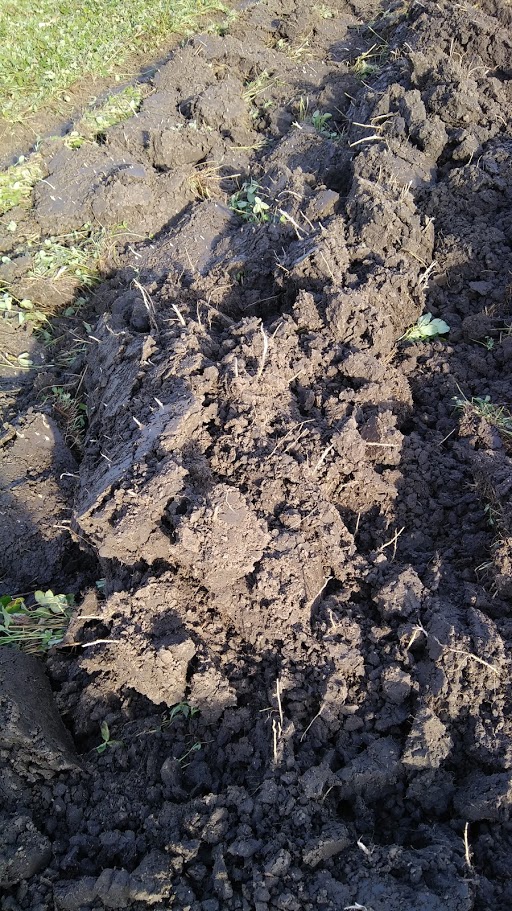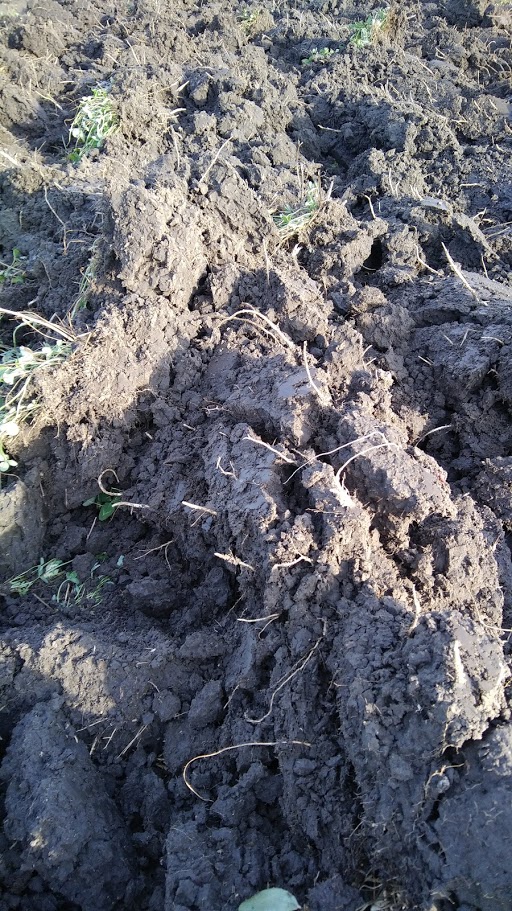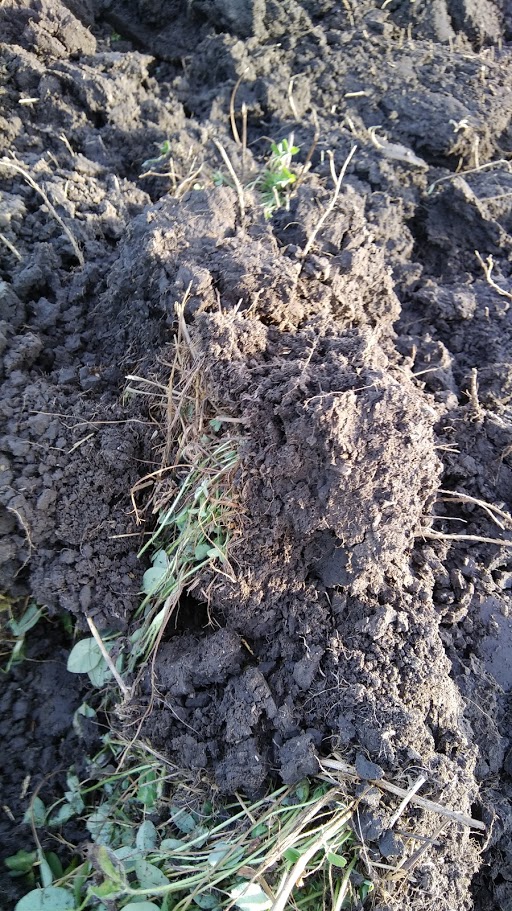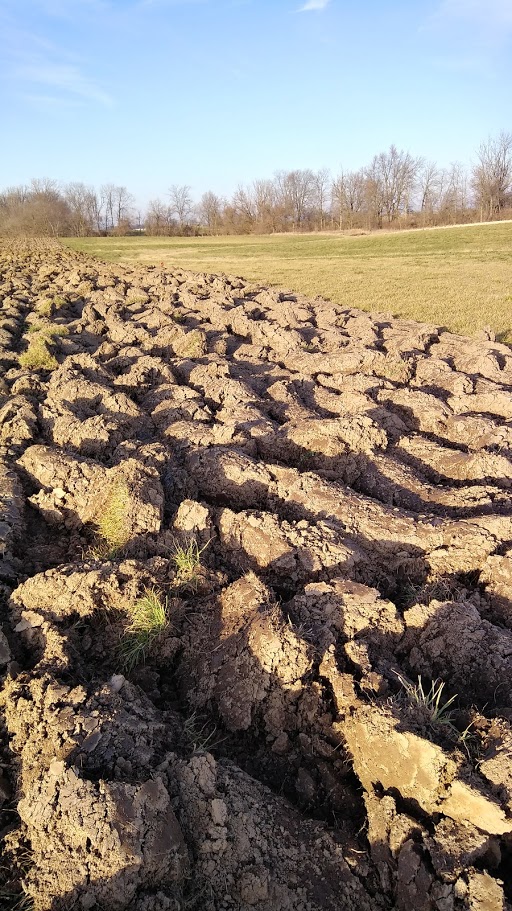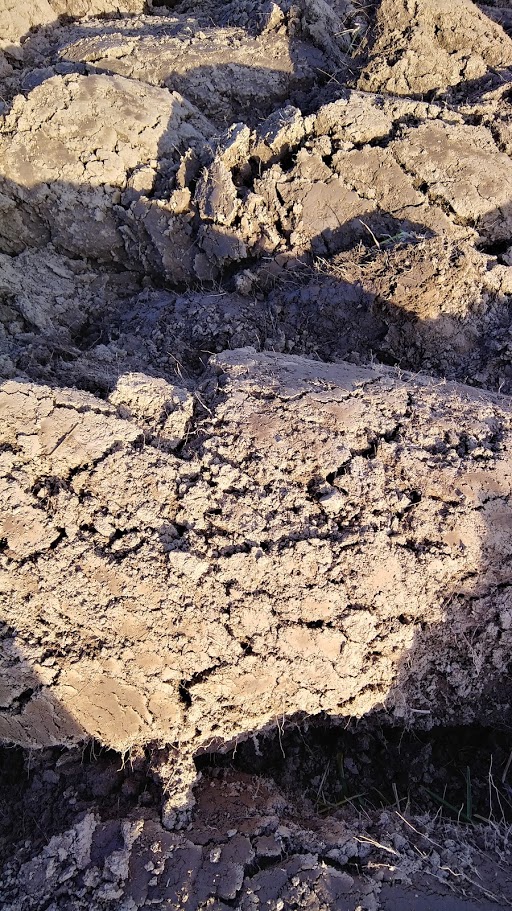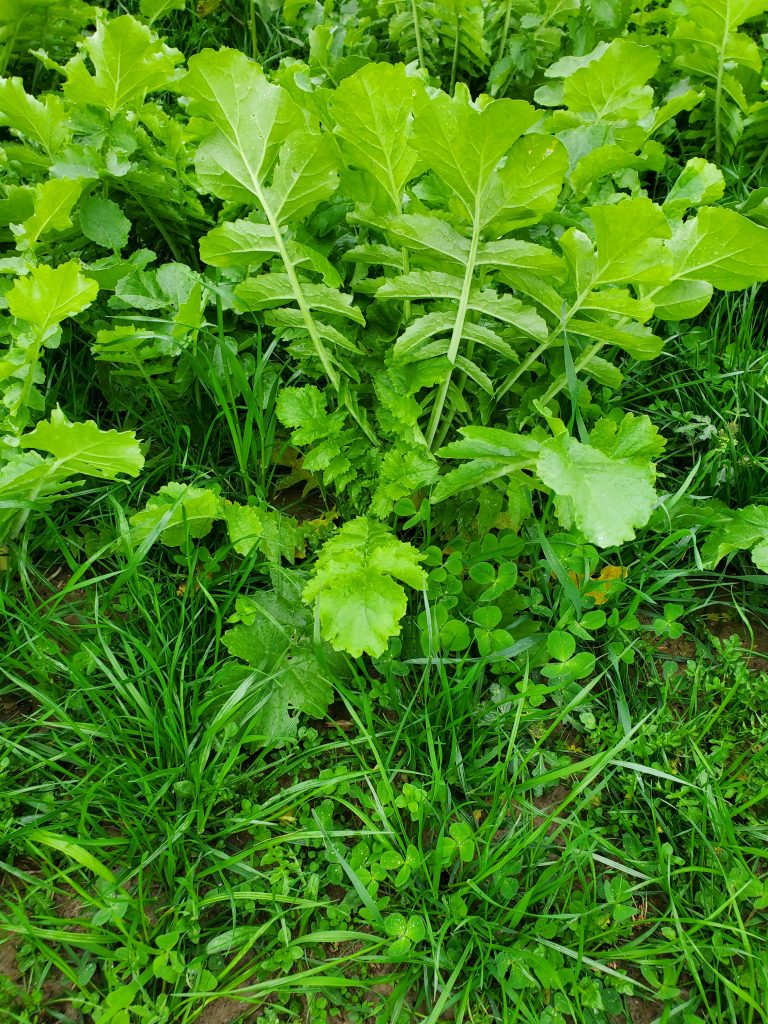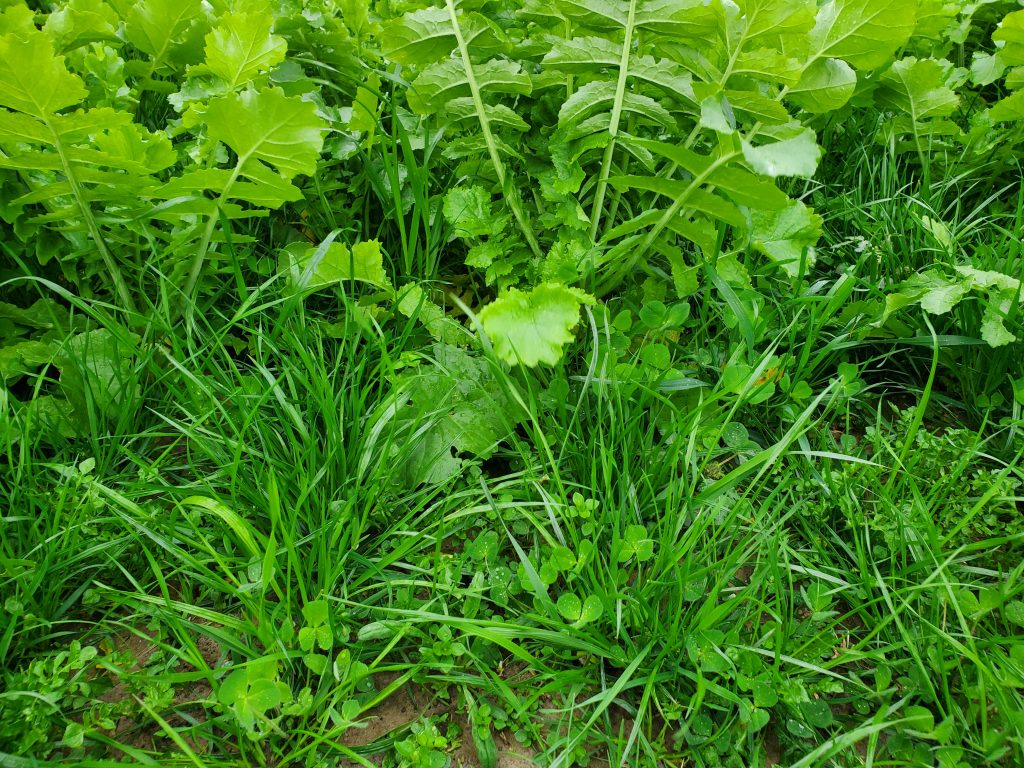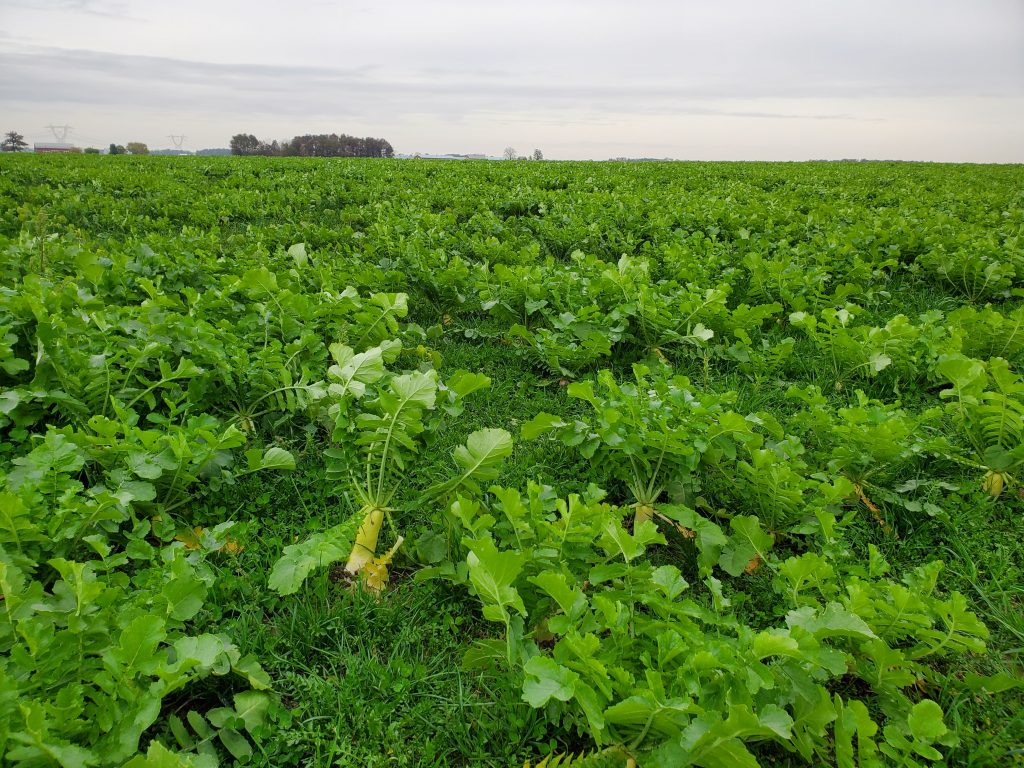I toured my fields on Friday, December 17, to document the results of cover crops planted in rather desperate conditions back in the fall. The purpose of the video is to show that even late, poorly planted cover crops are doing some good if one takes the time to look at ground level. My experiences this fall were also a good case study of seed-to-soil contact. Creative methods we used to get good contact in the mud paid off when compared to broadcasting.
Cover Crop Benefits
Buckwheat as Nurse Crop for Clover
by Dustin Johnson
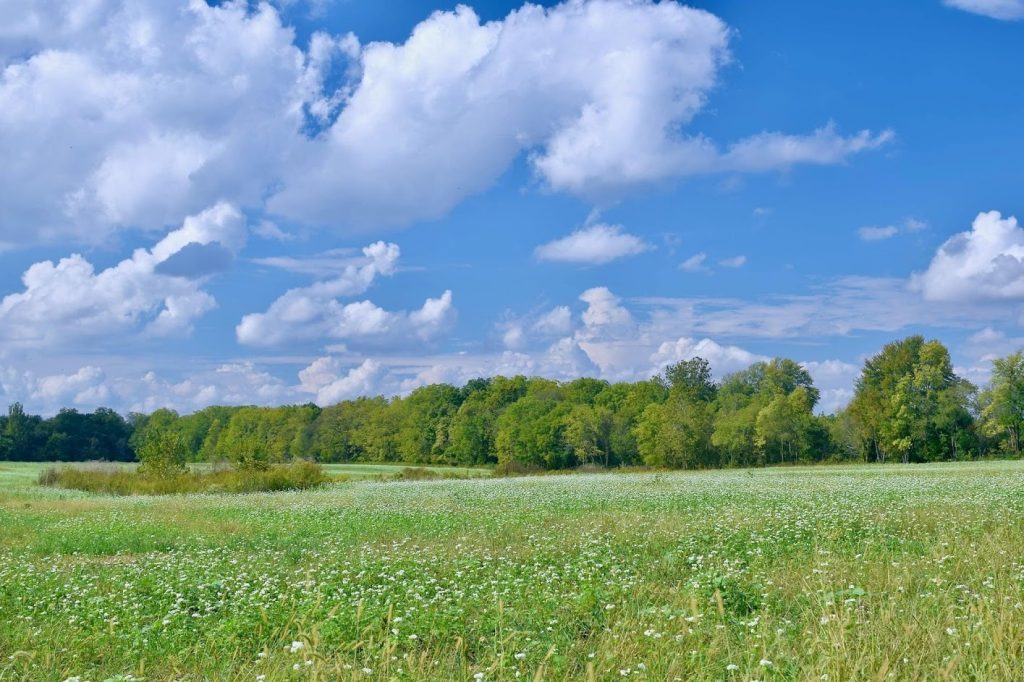
If I were to make a list of underutilized crops in American agriculture, buckwheat would be near the top. Buckwheat is a short-season broadleaf grain crop that is very easy to grow and can thrive in hot and dry conditions. As a cover crop, it is renowned for its ability to mineralize phosphorus from the soil as well as provide late-season pollinator habitat.
Buckwheat as a Nurse Crop
I planted buckwheat for a third use this summer – as a nurse crop for clover seeded after an organic winter wheat crop.
After harvesting wheat and straw in July, I left the ground fallow and controlled weeds with light tillage. I waited to plant my cover crop until daily 90 degree temperatures and drought finally eased on September 3rd.
The Final Mix
- 10 lbs Buckwheat – nurse crop/cover crop
- 10 lbs Cossaque black oats – nurse crop/cover crop
- 2 lbs Fixation balansa clover – N fixation
- 4 lbs Villana hairy vetch – N fixation
- 4 lbs AU Robin crimson clover – N fixation
- 2 lbs Peredovik sunflower – diversity
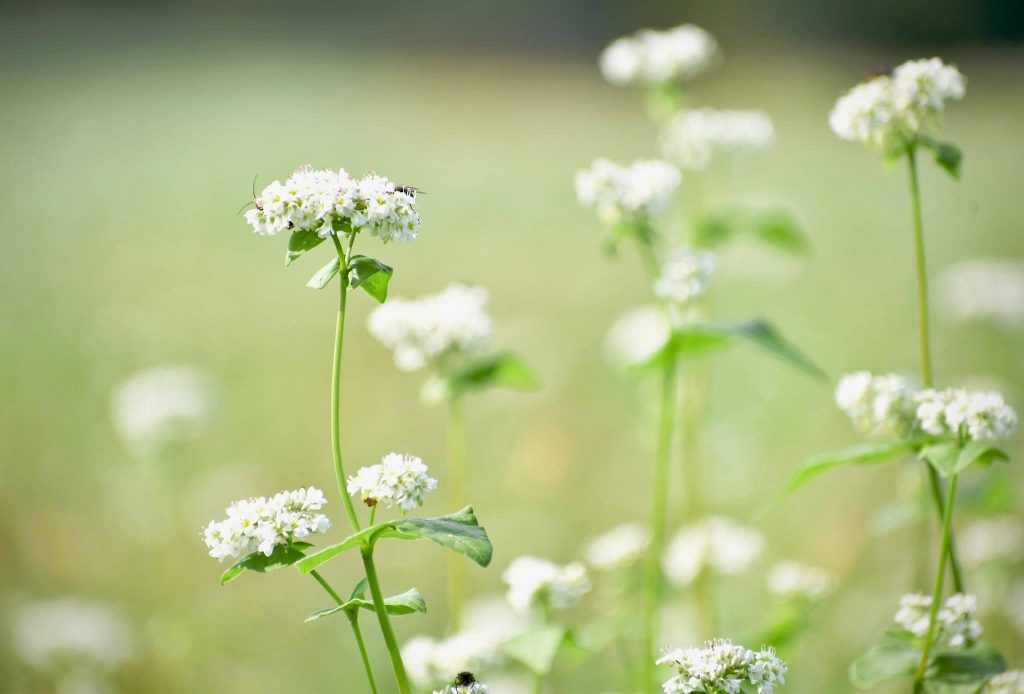
The buckwheat really impressed me as a nurse crop. It was the first seed to germinate and very quickly provided a moderate canopy over the entire field. Three weeks after planting it looked like an entire field of buckwheat!
This shading suppressed grass weeds like foxtail, but still provided enough light to let the clovers establish. Without the shading effect of buckwheat, the clover could not have competed with grass weeds that are better adapted to late summer growth.
In early October the buckwheat set seed and completed its lifecycle. The leaves have dried up and a freeze will soon stop any lingering growth.
The baton was passed from the buckwheat to the clover, which was by then poised to take full advantage of the late-season sun. Buckwheat proved to be an outstanding nurse crop for summer planted clover.
The only areas of the field where foxtail gained the upper hand were areas that did not grow a good stand of buckwheat. This was mostly in combine tracks and under the straw windrows. See the picture below.
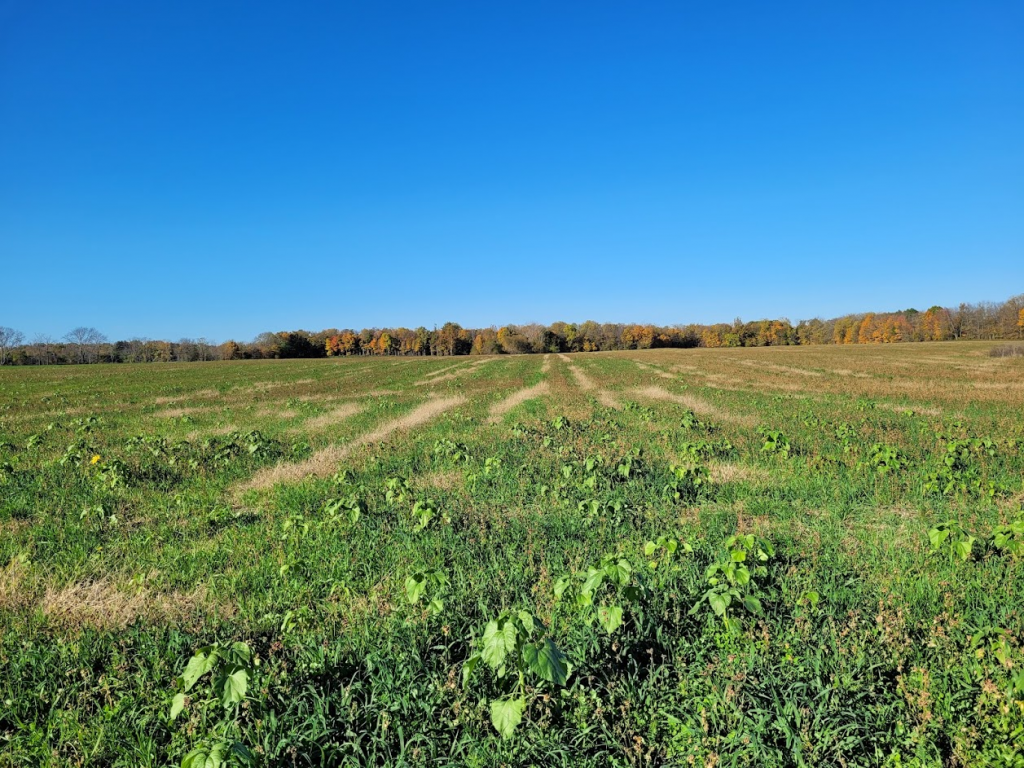
The final stand of balansa clover, hairy vetch, and crimson clover is very important on this field. It will be the primary source of nitrogen for next year’s crop of organic corn. I will provide an update on this field and expand on the role of each legume in this mix when growth resumes in the spring.
Benefits of a Pure Stand of Cover Crop Red Clover
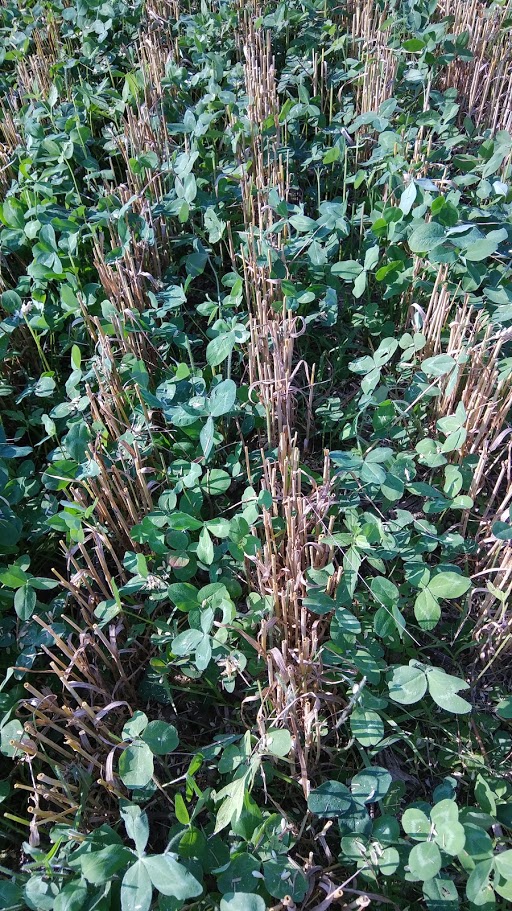
December 28, 2020
by Dustin Johnson
I recently plowed under a successful stand of red clover in an organic wheat field on my farm near Kokomo, Indiana. I have grown alfalfa and mixed stands of hay as a cash crop for my entire career. Five years ago we began experimenting with organic grain production to try something new and take advantage of the synergies between organic grain farming and our existing hay business.
This was my first experience growing a pure stand of red clover. The main goal for the stand was nitrogen fixation for next year’s organic corn crop.
Along the way, I also gained a forage harvest, weed suppression, and soil health benefits. Please read further for a more in-depth discussion of my experience and the benefits that this time-proven practice can bring to your farm.
FROST SEEDING
On February 21st, I broadcasted 15 lbs/acre of red clover seed into my dormant wheat field. Frost seeding should take place near the end of winter when a period of nightly freezing and thawing is anticipated. The ground was frozen enough to hold up the tractor and the field contained a light dusting of snow. This helped me see the spread pattern of the clover seed.
Red clover is my personal first-choice when frost seeding: The seed is relatively inexpensive, clover can thrive underneath a crop canopy, it can be harvested for dry hay, and it works! Red clover seeds are heavy and round with a high level of seedling vigor. They naturally sort through material on top of the soil and fall into the “honeycomb” of soil cracks created by frost. This is the same process by which red clover stands naturally persist on road sides and barn lots.
If grazing is your primary goal, plant an improved species such as Bearcat or Gallant. White and berseem clover can also be successfully frost seeded for forage use. If you plan to exclusively grow it as a cover crop, sweetclover and mammoth red clover are also good choices.
Around the time my wheat broke dormancy, the red clover seedlings emerged. The frost seeded clover scavenged sunlight that filtered through the rows of wheat, but grew more slowly than the wheat and stayed beneath the wheat canopy. The presence of red clover in the wheat field did not interfere with the wheat’s ability to grow or be harvested. From the road, the wheat looked like a normal wheat field. Only after harvest was a carpet of green growing clover revealed.
FORAGE HARVEST
Once the wheat was harvested and the canopy opened to the red clover, it grew very quickly. I mowed the red clover for hay about a month after wheat harvest on August 19th. The clover was nearing full-bloom and the weather was right. The hay was mostly red clover, but also contained a few weeds and about 4” of wheat stubble. This medium-quality hay was the most fragrant, sweet-smelling hay that I have ever baled! Yield was also impressive: 2.3 dry tons/acre in a single harvest. Even priced modestly, this hay harvest was a significant boost to the profitability of my wheat crop.
COVER CROP VALUE
After taking a cutting of hay in August, I let the summer regrowth accumulate for a green manure to plow down. The regrowth was vigorous and thick. Weeds that had been present in the growing wheat were mowed before going to seed by the wheat and hay harvests. Newly germinated weeds could not compete with the established red clover. This certified organic field was nearly weed-free in late summer.
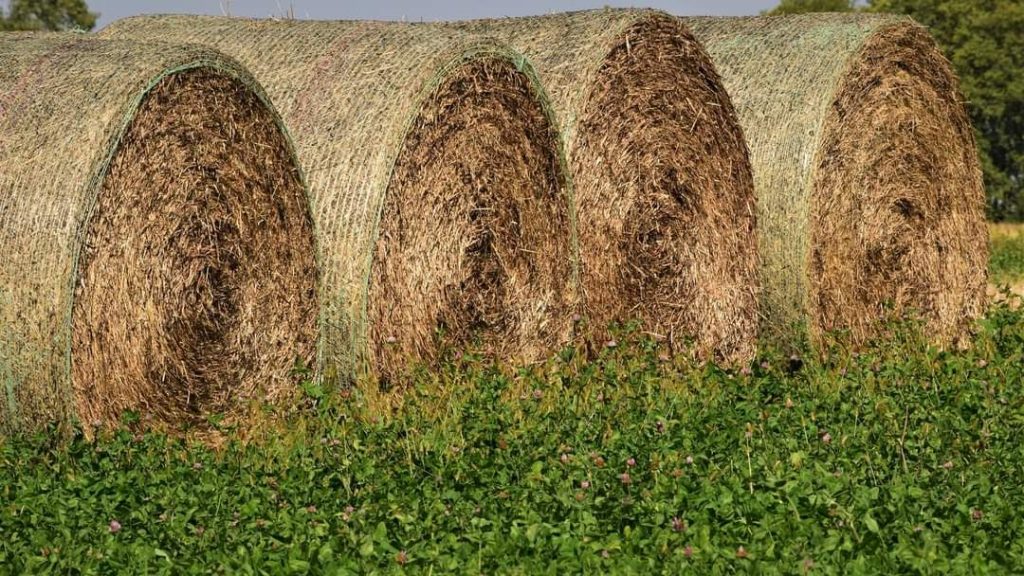
The clover bloomed again in September and was a haven for wildlife and pollinators.
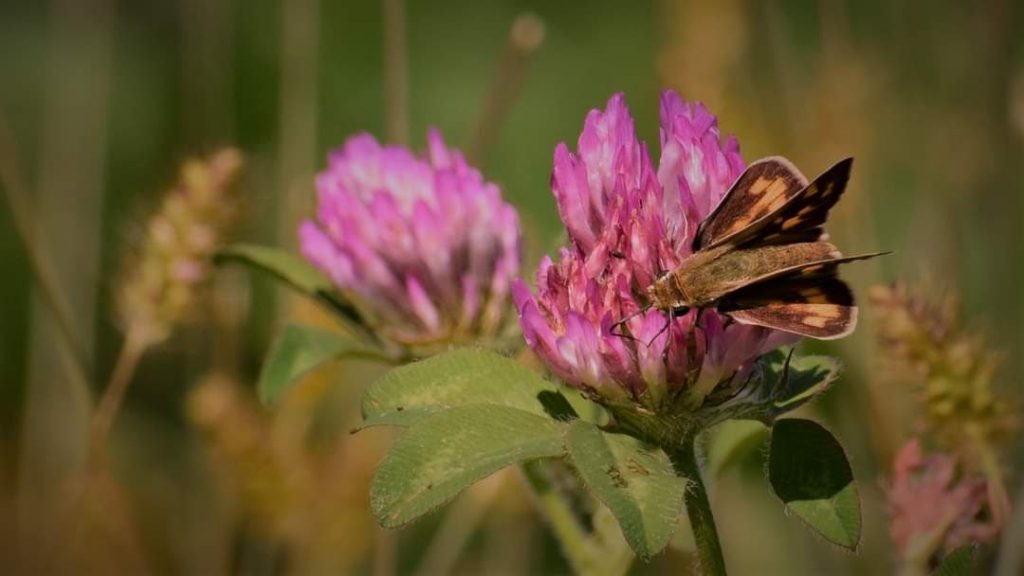
In early December, I moldboard plowed this land and the red clover again showed its value. The clover was still actively growing and removing water from the soil. Areas of the field that did not have a good stand of clover were noticeably wetter. The clover taproots penetrated the plowing depth and prevented the wetter clay soils from “slabbing.” The pictures below show the loose friable soil created by the clover roots compared to an area of shallow-rooted grass sod plowed at the field edge.
Note the difference in the above plowed soil (with clover) vs. the soil below (no clover).
Those same roots will provide a soil health benefit below the plow layer as well. The clover taproots penetrated the soil much deeper than the plowing depth. The roots will help prevent a plow pan from holding water when they decompose this winter and drainage occurs in the old root channels.
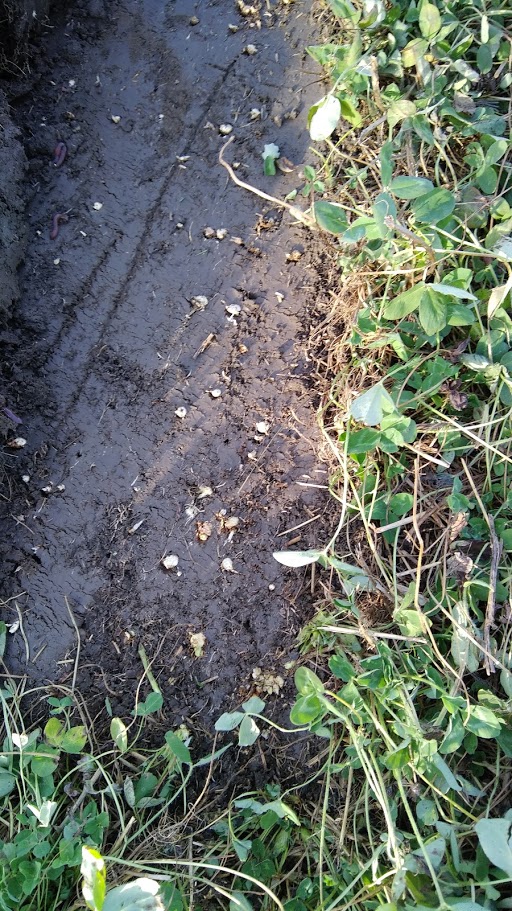
The red clover has now begun to decompose within the soil profile and will be releasing nitrogen for my organic corn crop next spring. University sources estimate that a successful stand of red clover that is terminated after blooming can release 70 to 120 lbs of N per acre.
Now is the time to make preparations for frost seeding clover on your farm. Whether your goal is nitrogen fixation, improved pasture quality, or soil health, frost seeding clover this winter is an easy and cost-effective way to achieve big results.
An Excellent Cover Crop Mix Ahead of Corn
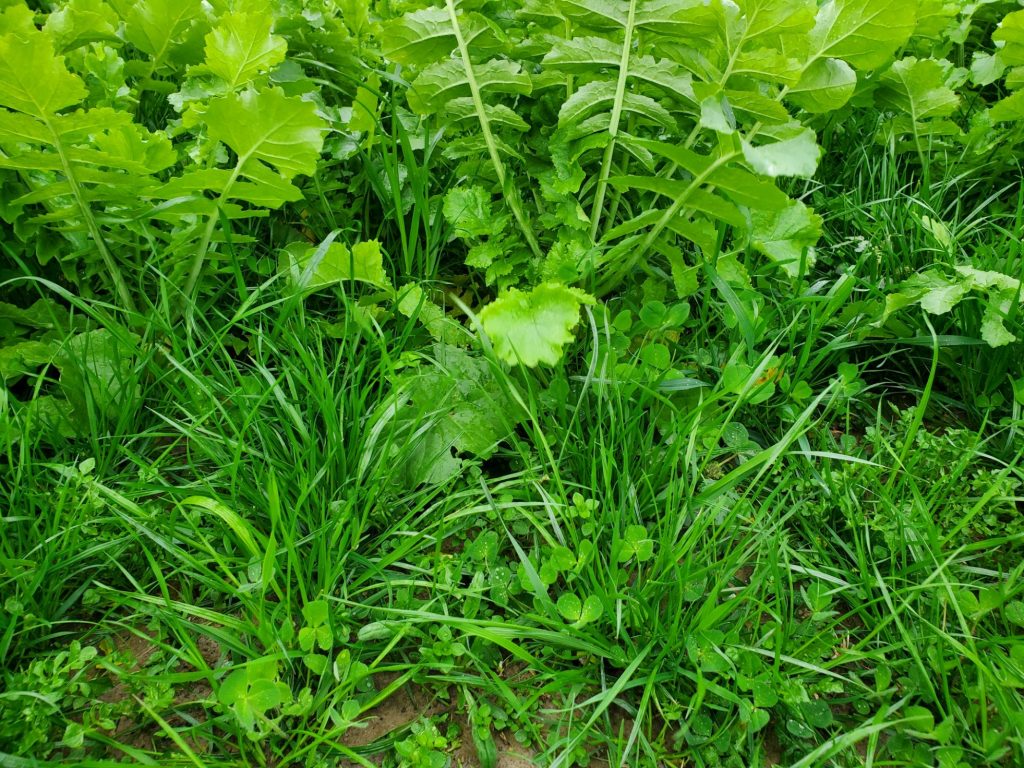
The mix pictured above is Nutribuilder Mix. It’s a three way mix of annual ryegrass, clover, and radishes.
This field was planted on August 18 at 25 pounds per acre. The included pictures were taken on October 30. The plan is to plant this field into corn next year.
The growth in this field shows the importance of a timely planting date. This is especially important for the radishes, since they will winterkill – and the farmer will want maximum benefit from them before they die.
Benefits
Each component in this mix will enhance the performance of the soil and improve the productivity of the following year’s crop. And of course, the long-term benefits associated with the ongoing use of cover crops are hard to quantify.
But what are some specific things to expect from each of these components?
Annual ryegrass
Annual ryegrass provides one of the best cost-to-benefit ratios of any cover crop, maybe the best. It’s inexpensive, versatile in application (aerial, broadcast, drill), and provides tremendous value to the soil. Annual ryegrass breaks up compaction, allowing better water infiltration. The depth of the roots provide access to parts of the soil previously unavailable to the cash crop. The fibrous root system near the soil surface helps prevent erosion. Annual ryegrass is an excellent scavenger of leftover nutrients, holding them for use later in the growing season.
Crimson clover
Crimson clover is an excellent choice for building nutrition into the soil. If you’re looking to build nitrogen for your cash crop, crimson clover provides that service. Since it will survive the winter, it will provide biomass as well. The crimson clover will also help the annual ryegrass and radishes to grow bigger and provide more benefit to the soil as well, as demonstrated by this video.
Radish
Cover crop radishes have been the super stars of the cover crop world. Their benefits have been noted over the years. They:
- scavenge nutrients from the soil (especially nitrogen).
- penetrate the soil, therefore reducing compaction.
- enhance soil percolation and aeration.
- provide an excellent environment for earthworms.
- provide deer and cattle an excellent wintertime feed.
- die in the winter.
Conclusion
Taking all of this information into consideration, this type of mix is an excellent choice to plant in the fall before planting corn the following spring. Keep in mind that only the radish will winterkill, so you will need a plan to terminate both the annual ryegrass and the crimson clover.
New articles out on Cover Crops in the Upper Midwest
During the week of March 18-21 I spoke at the Legacy Seeds Cover Crop Meetings to over 150 people in three Wisconsin towns
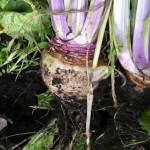
about cover crops. During each meeting I showed why folks should consider using cover crops (erosion control, nutrient management, compaction reduction, aeration/infiltration, etc…). I also implored producers to be creative about applying cover crops (aerial application, Hi-boy type spreaders, maybe interseeding into short corn, etc…). Lastly I showed how many farmers are reporting increased profitability by using cover crops.
Many farmers attending the meetings had at least some experience with cover crops and those that talked to me personally had very good experiences. It was fun to talk to farmers that are excited about both soil health and profitability.
At the meeting in Sparta, Agri-View Newspaper Crops Editor, Jane Fyksen was present and taking notes for a story she was writing for the publication. Jane did a great job in her reporting of what I said. I want to share those articles with you. The first article is entitled “Finding a cover crop mix to fit every need” and the second one is entitled “Aerial and overseeding of cover crops: Making it work“.
I have conducted over 40 cover crop talks this year from Omaha to Ontario and from Syracuse, NY to Chippewa Falls, WI. I am amazed how far this cover cropping idea has come. I am also very excited to see what will happen in another 8-10 years.
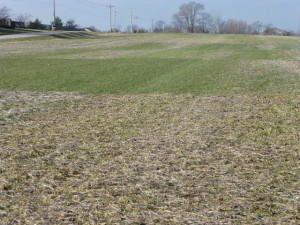
Badger Plot Cover Crop Research Site – Producer Day Schedule Announced
Join me with Wisconsin NRCS at the Badger Plot Cover Crop Research Site on October 2, 2013 @ Jeff and Jerry Kreuziger Farms near Clyman, WI. Sessions will run from 9:30-Noon or 1:00-3:30 CST. This looks to be a great day to learn more about cover crops and soil health in southern Wisconsin/northern Illinois regions.
For more information see Badger Plot Research-Producer Day.
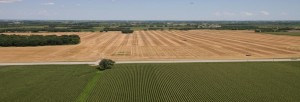
Advancing Cover Crop Adoptions Research Agenda
Advancing Cover Crop Adoptions Research Agenda
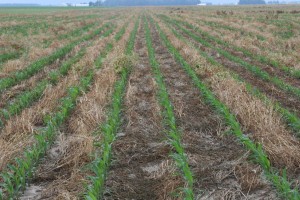
Sarah Carlson, Midwest Cover Crop Research Coordinator with Practical Farmers of Iowa and Ryan Stockwell, Agriculture Program
Manager with the National Wildlife Federation have written an agenda that will help researching cover crops be more scientific over the next six to eight years. The research agenda is published in the Journal of Agriculture, Food Systems, and Community Development
ISSN: 2152-0801 online www.agdevjournal.com
Here is the abstract of this aggressive agenda:
Copyright © 2013 by New Leaf Associates, Inc.
Abstract
Given certain ecologic and agronomic characteristics of conventional corn and soybean monocultures, cropping systems reliant solely on these two commodities inevitably lose soil and nutrients. Leaky cropping systems not only hamper society with negative externalities, but also erode the very natural resources needed to produce food and sustain civilization. The United States Department of Agriculture (USDA), state agriculture department staff, farmer organizations, agribusiness leaders, and conservation and environmental organizations now see cover crops as a solution to reduce the negative externalities of conventional row-crop agriculture. Farmers are asking for increased agronomic and economic research to help them understand the benefits of and implement the use of cover crops. Researchers for the most part are not keeping up with farmers’ innovations on cover crops nor on providing the information sought by farmers. This article outlines the questions farmers are asking about cover crops and provides suggestions to agronomists, soil scientists, and researchers on research topics to best answer those questions. Additionally, social scientists must initiate a new round of research to understand the underlying concerns farmers have with cover crops and help to define the information (both content and source) that best informs and influences farmers. This article outlines specific issues and questions social scientists can research to contribute to the advancement of more sustainable farming practices and, in particular, cover crops.
Keywords
adoption, climate change, cover crops, diversity, externalities, innovation, natural resources, nutrient loss, resilience
You can find the complete paper here.
Fall Cover Crop Management
While in southern Minnesota in early September 2013 I was asked when a farmer should plow his cover crop field this fall because he needs the fields to be “black” this winter in preparation for next spring. I shuddered. There I was in a beautiful field of cover crops that are jump-starting some biology on a “biologically dead” field and the farmer wants to kill his biology driving mechanism. UG! The main reason he wanted to till the field was to have warmer soils in the spring where he had black soil. I shared that our research sowed much different results. His thought process sound right but has proven to be a myth, not a fact.
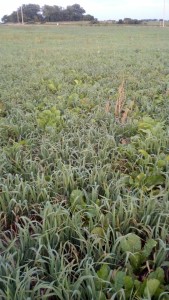
I told the farmer to leave the cover crops in all winter and use conservation tillage next spring. (He’s not a no-tiller.) We dug some shallow root pits for a field day and we found many problems that I believe can be somewhat rectified if the cover crops are left in all winter.
We found many soil health problems in this prevent plant field
- Severe compaction– many areas had compaction starting at 2-3″ deep. Part of that was from spring tillage of wet soils…but the compaction was about 8″ thick as the soil was coming up in blocks the size of cinder blocks!
- Lack of soil biology – I know this because we found a significant amount of corn fodder 2 foot deep that was not even breaking down. It would have been buried with the deep ripper 18 months ago. I could not believe my eyes!
- Lack of aeration in the soil – the soil was literally rock hard. We did find a few earthworm channels but it was so dry that worms were small and deep.
- Low organic matter – I’m not sure how low it was but there was very little soil structure. I talked with a regional NRCS employee and the local SWCD specialist and both men lamented that many of the soils in that region were “about as bad as this one”.
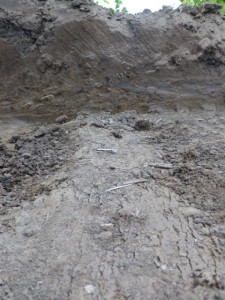
I need to be fair. The farmer currently renting this field has only farmed it a few years and he is making major strides to improve this farm. But he has lots to accomplish before he has a healthy field. Having cover crops are a great first step and he knows it.
Other solutions (instead of cover crops) being proposed to fix the “tight” soils (“unhealthy” soils) in the region
- Tile – LOTS and LOTS of tile has been installed in prevent plant acres this year. Farmers know they need aeration and percolation in their “tight” soils. The regional specialist from NRCS lamented that many farmers don’t believe that cover crops are a solution to make their soils better long term. Tile is not bad; but tile and cover crops are a much better solution.
- Deep ripping – this will get air into the soil and break up compaction, but will it build soil health? No, it will not (note the corn fodder found 2 foot deep in a root pit). Let cover crops naturally deep rip the soil.
- Tillage- and lots of it – many fields in the area had been tilled (disked, field cultivated, etc…) four times already to control weeds…Unfortunately it also reduces organic matter and soil structure and soil health.
So what should happen with the cover crops heading into winter?
- Leave the cover crop growing into the winter – This will give the best opportunity to help with aeration and percolation. This also helps build soil structure and reduce compaction. (See deep ripping, and tiling above…just let the cover crops do this naturally!)
- Sarah Carlson from Practical Farmers of Iowa recently wrote an article about this topic and you can find it here Prevent Plant, Cover Crops, Now What 2013.
- Let the cover crops keep putting down deep roots – we found roots of crimson clover, radishes, cereal rye, annual ryegrass, oats, and Pasja all around 24″ deep. Let them keep growing deeper to open up the soil to get air and moisture deeply into the soil profile.
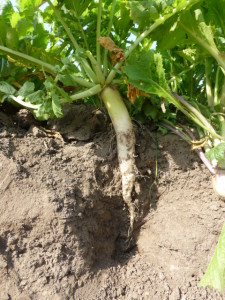
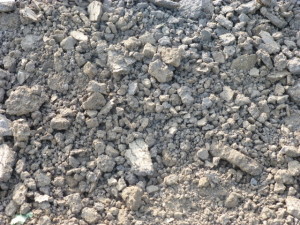
Cover Crop Field Day Set in Blooming Prairie, MN
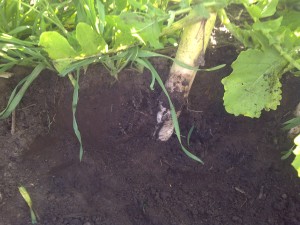
Cover Crops will be the main topic of discussion on September 4, 2013 at a cover crop field day and meeting in Blooming Prairie, MN. I have the privilege of speaking at this event as we look at cover crops on prevented plant acres. We will also look at what cover crops work best in the upper Midwest. We will be on Brad Hagan’s family farm and possibly look at Dale Ramsey’s farm too. Please note that we will be looking in root pits (where the action really is)!
I received this note from Legacy Seeds representative Andrew Heath about the field day/meeting:
“We plan on structuring the event much like an open house with designated times where you will be able to address the crowd. We will start the event at 10 am and have you speak from 11 to 11:45 and again at 1 to 1:45. There will also be transportation to the cover crop plot and some of the field that you, TJ, Brad and I visited earlier with root pits dug. This will happen from 12 to 1 and 2 to 3.”
I have seen the plots and have added photos here on this post to entice you to come if you are in the region.
As a side note, Hagan farms will be no-tilling corn into these fields in 2014. We’ll follow-up on these fields next spring and see how these fields compare to others that did not have a cover on them.
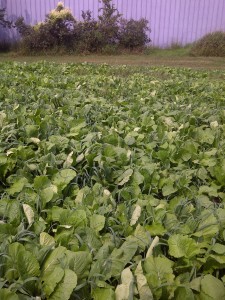
Cover Crops to the Rescue!
A Huge Problem
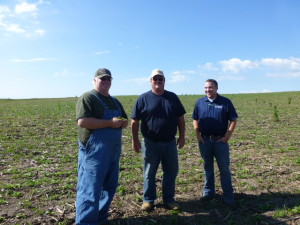
Recently I was in Minnesota with Brad Hagen, T.J. Kartes, and Andrew Heath looking at Brad’s 1,000+ acres or cover crops. Brad had not intended on planting any of theses acres to cover crops in July, 2013…his intentions were to plant them in August or early September. But spring 2013 rains and floods kept Brad from planting corn or soybeans on most of his 1,700 acres near Ellendale, MN (about an hour SW of Rochester, MN ). Brad attended a cover crop meeting TJ set up for me to speak at on behalf of Legacy Seeds last March and as I spoke I could see Brad’s mind working. When the spring rains came so did phone calls from Brad to TJ and from TJ to Andrew or me (or both)…”what can I do to build soil during this disaster?” was the theme of the weekly (if not daily) phone conversations.
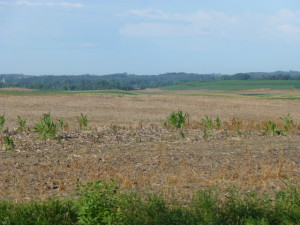
Cover Crops to the Rescue!
Brad’s goals are to build soil and to scavenge nitrogen from his hog operation and build nitrogen with legumes. Realizing that we would plant in early-mid July and not in mid-late August we all understood that we did not want to have to mow to remove seed heads if at all possible – so we left Radishes out of the mix. We also realized that we wanted to use a “summer” clover, so we used Berseem Clover for it’s excellent growth and N producing ability. We chose Oats as the grass in most fields and then we added a twist, Pasja or Vivant Hybrid Brassica. I have worked with Pasja for over 10 years and rarely ever saw it produce a seed head in the summer or fall. While Pasja (nor Vivant) have a big tuber like a Radish they do have the ability to scavenge a tremendous amount of nitrogen and earthworms dwell around their roots.
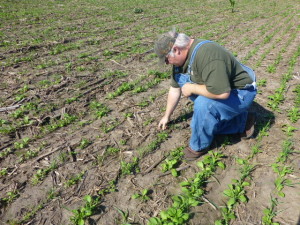
In some later July (and soon to be mid-August) planted fields we chose to use Spring Barley and Crimson Clover along with PileDriver Radishes and Appin Turnips. TJ and Brad requested this mix so we’d get later fall growth, deeper penetration through compacted soils (Radish vs. Pasja/Vivant) and excellent N production from the Crimson clover. Spring Barley was available and many folks in Kentucky have told me that barley makes the soil “sweet” (whatever that means). From experience I know that soil after Barley is quite mellow.
Early August Report
From what I saw on August 1 I was very impressed! As other folks in the region were planting straight Oats or possibly a few were adding Radishes very few other folks seemed to totally share Brad’s goals. Brad told me that he is doing these cover crops because he wants to build his soil and because he wants his 7 year old son to have better soil to farm when he grows up and farms his place like Brad does with his father. I’ll have more photos in a month or so. I believe Andrew, Brad and TJ will plan a field day for September. It’s beautiful country near the Hagen farm…it probably will be worth the drive in September to meet Brad and his family. They’re pretty special folks…
Take a look at my You Tube channel “covercropdave” to watch an interview I have with Brad and TJ.
